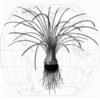| Publication Type: | Journal Article |
| Year of Publication: | 1976 |
| Authors: | J. M. Pettitt |
| Journal: | Journal of Cell Science |
| Volume: | 20 |
| Issue: | 3 |
| Pagination: | 671 - 685 |
| Date Published: | 1976/// |
| Abstract: | The megasporocyte of Isoetes englemanni at the leptotene-zygotene interval of meiosis contains 4 disk-shaped proplastids about 12 mum in diameter. The disposition of these organelles in the cell is such that each of the four megaspores delimited during cytokinesis contains a single proplastid. During prophase and following their incorporation into the spores, the proplastids are undergoing fission by budding. The buds are first discernible as low surface evaginations which contain a complement of granular somal material, some wefts of tubular membrane and osmiophilic globuli, in addition to a number of vesicles derived by invagination from the inner membrane of the proplastid envelope. As the evaginations emerge they enlarge and the link with the parent body is reduced to a narrow channel. At this stage one or more of the vesicles derived from the proplastid envelope comes into register with the lumen of the channel. One vesicle is transported into the lumen, elongating as it passes through. The passage of the vesicle into the channel destroys the connexion between the matrix of the evagination and the stroma of the proplastid. The occurrence in the cytoplasm around the proplastid of bodies not connected to the proplastid, but identical in structure to the evaginations and carrying a membranous tail suggests that the evaginations are released by abscission of the channel close to the surface of the parent body. After release the bodies undergo division by constriction. Regression of the tail follows division in those bodies which are regular in outline and in which the matrix is ultrastructurally similar to the stroma of the parent organelle. The process does not seem to occur in co-existing forms which have assumed an irregular outline and have a less-opque matrix. The more mature megaspore of Isoetes contains proplastids up to 4 mum in greatest dimension. The stroma in these is dense and granular and contains membrane-bound vesicles, osmiophilic globuli, starch granules and wefts of tubular membrane. There is no evidence that the large budding organelle persists to this later stage in development. The resemblance of the plastids in the more mature megaspore to the bodies produced by evagination earlier in development suggests a common identity. The observations and interpretations lead to the proposition that the plastids in Isoetes englemanni are autonomous. This situation contrasts with the one described for another heterosporous haploid dioecious pteridophyte, Marsilea vestita, where nucleocytoplasmic interaction has been interpreted as the de novo creation of plastids and mitochondria following the elimination by autophagy of the organelles inherited at meiosis. It is suggested that an explanation to account for the 2 different mechanisms might be sought in regard to the degree of developmental success enjoyed by the individual megaspores in the 2 plants. In Isoetes all 4 megaspores of every tetrad survive and develop, while in Marsilea the mature megasporangium contains a single functional megaspore. |
| URL: | http://www.scopus.com/inward/record.url?eid=2-s2.0-0016959322&partnerID=40&md5=5b699689f3109fc8a2df781b018388c8 |
